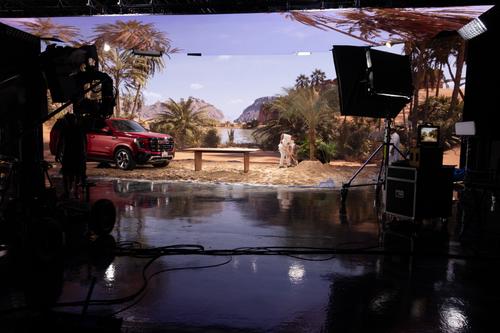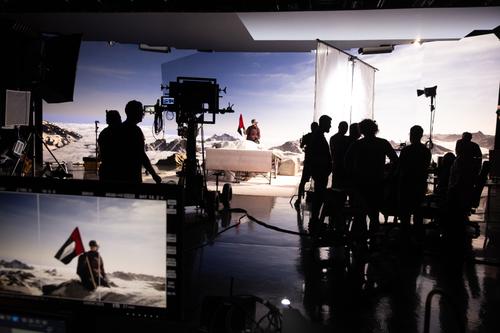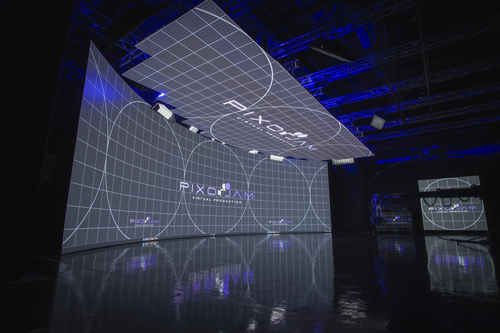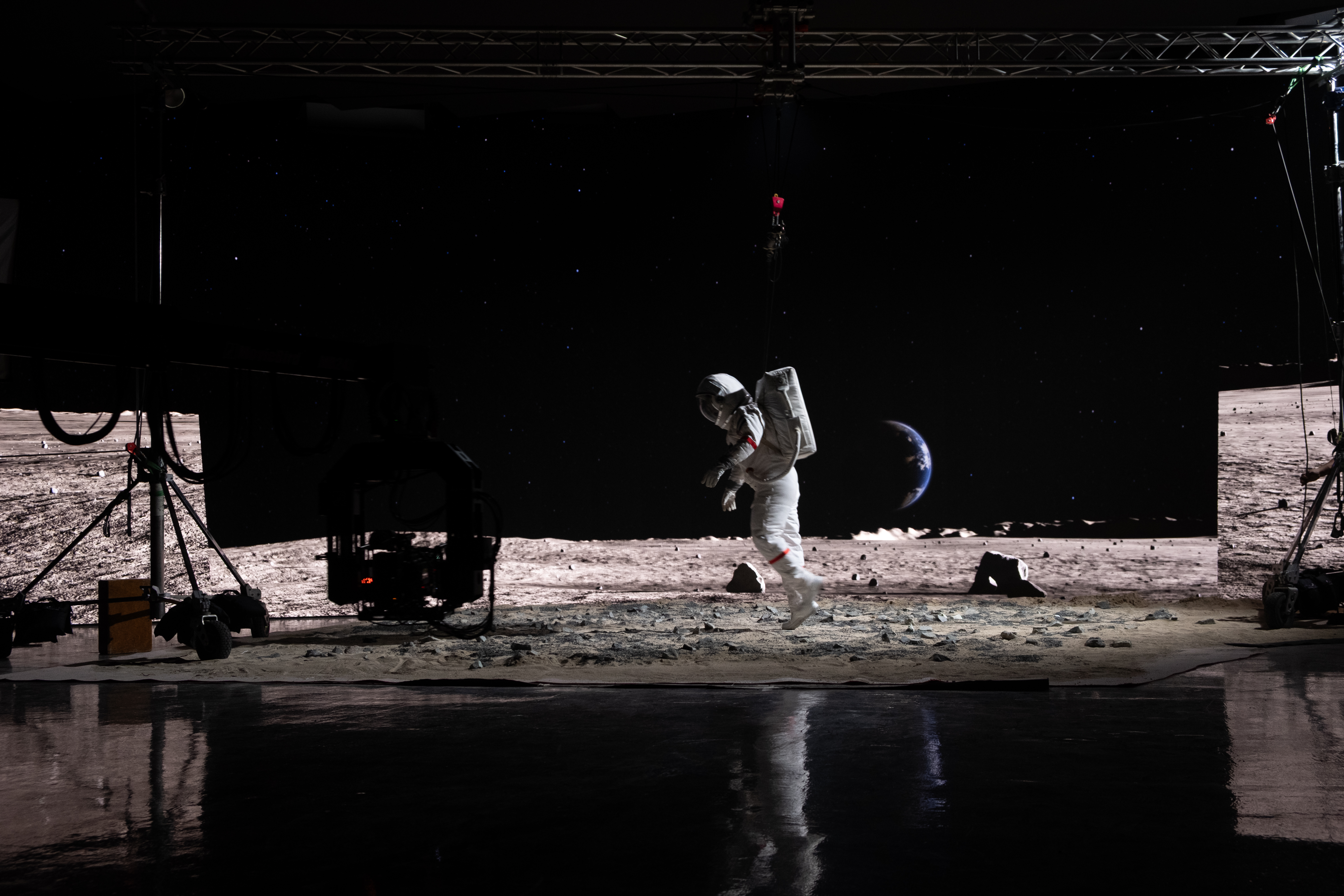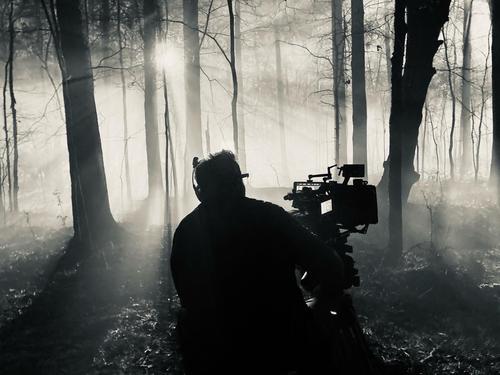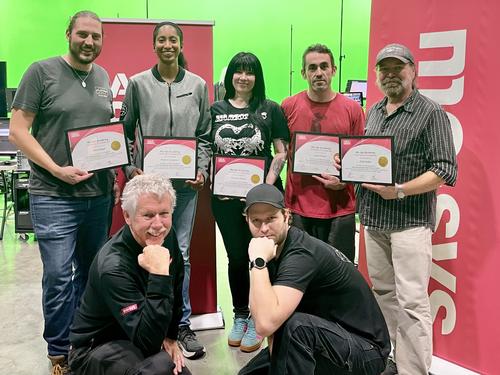Pixojam - A Jewel in the Desert
A tour of the studio driving Virtual Production forward in the MENA region
Looking out of the driver’s side window as we cruise up the E66 towards Dubai, it’s hard to miss the Mohammed bin Rashid Al Maktoum Solar Park and its massive tower, a shining beacon of sustainability just 50km to the south of the city. However, we’re not here to see solar panels, but rather to take a tour of a very different jewel in the desert, the Pixojam studio.
As we enter the full-scale Virtual Production (VP) studio, first to greet us is Archie, who runs over enthusiastically… wagging his tail. Archie is the studio mascot and Pixojam’s official ‘Chief of Chewing’.
Archie is followed up by Michael Lagerwey, COO, who comes around from behind the 12m long brain bar of high-spec workstations at the back of the studio.
Archie has more freedom to roam right now, as the Pixojam team are in pre-production. Indeed, they have just finished up a production meeting for the latest car commercial that they will be shooting in the studio in just a few days.
Whilst Michael takes us on a tour of the facility, the rest of the team continue to focus at the brain bar, developing environments in Unreal Engine and testing their performance on the impressive 18x5m LED wall. On the stage are two MovieBird cranes, with Sony Venice 2 cameras, each tracked by a StarTracker Max. So, who are Pixojam? Michael explains.
“Pixojam is made for filmmakers by filmmakers. We are an autonomous VP studio. From A to Z, we have all the skills for a complete production. Camera and lighting. Editing, colour grading and all post-production happens upstairs. Behind the brain bar we have three Unreal Engine artists.”
A driving force for Virtual Production
Michael begins to explain the Pixojam business model.
“The Studio in Dubai is 95% TV commercials. We do a lot of real estate, and a lot of car commercials.”
Hugo Weichert, the VP Supervisor, comes around from behind the brain bar to join us, jumping into the conversation.
“There’s a very large market for automotives here. It ends up being much cheaper for clients to shoot in VP. With traditional shoots, you need two cars, but with VP they only need one - there’s no way you’re going to crash the car on the stage! In the studio, you have complete control over all the lighting, reflections, and what’s being highlighted on the vehicles. Plus, if it’s an unreleased vehicle, a ‘red code project’, they can maintain confidentiality, because no one outside the studio will ever see the car during the shoot. The vehicle unloads inside the studio, directly onto the set.”
The lonely road
Pixojam is the only fully equipped, autonomous Virtual Production studio in the Middle East and North Africa (MENA) region, so whilst that makes them the go-to, it also presents some challenges. As Michael explains, you can’t go next door to borrow a cup of sugar…
“We just came back from IBC. In Europe, everybody knows everybody, but we are alone here in Dubai. There are no other VP facilities within 1000km, so we need to be efficient and self-sufficient. We have a lot of spare tyres!” Michael laughs.
Spare tyres
What is immediately apparent about the Pixojam family is that they have a perfect balance – warm, welcoming and relaxed, but also experts in their respective fields with a commitment to serving their clients with absolute professionalism. We take a pit stop at the brain bar to discuss the team and how their skillsets influence the Pixojam VP workflow.
“We want to be able to multitask,” says Hugo. “It’s not just someone working on the video processing and another person in charge of the tracking. Michael comes from film, I started in gaming, Mina in architecture. We all have different specialities and specific expert skills, but it’s very important to be able to multitask and for each of us to understand the full process. Everybody here has a baseline set of skills so that any one person can run the studio by themselves. Of course, we hope that never needs to happen!”
“I just trained with the StarTracker and learned lens calibration,” interjects Mina Hosseini, one of the 3D Environment Artists, leaning around from behind her monitor.
No roadmaps
Don’t be fooled into thinking of Pixojam as pioneers. For Michael and Pixojam CEO Azin Samarmand, the decision to establish the first VP studio in MENA was founded on the principle that Virtual Production has matured into a complete professional workflow. That doesn’t mean there weren’t a few bumps in the road as they set up the new studio…
“We started Pixojam four years ago from scratch, right after Covid, with absolutely no blueprint for Virtual Production. We did a lot of research, building the servers and selecting an LED wall, but that turned out to be quite difficult…”
As we start to head over to the wall, Michael looks up at the huge, curved LED volume, the team behind us continuing to test one of the environments they are working on. He shakes his head incredulously.
“This? This you cannot test before! You order it from the manufacturer and then you’re receiving the LED, so once you receive it... ‘Okay, this is what we have to work with’. We made a lot of good choices during the initial setup. The cranes, the Sony Venice 2, StarTracker Max, but the first wall, we were not very happy with that… But we chose much, much better with the second wall, so now we have excellent performance and the ability to shoot with a high refresh rate.”
The Pixojam LED volume is large and impressive, but not too big. Hugo elaborates.
“When you have a big film or a TV series, you need a larger stage. But if you want to be a sustainable business, you need to scale to your market. This is a mistake a lot of new studios make, especially two or three years ago, when VP was first getting big, with these huge stages being built, usually for specific projects, but then they couldn’t sustain themselves afterwards, because they were just too big for the market.”
Michael nods adamantly.
“You need to have the size that you want, the correct size to be able to do the work, but also to be able to deliver at the price point for the market and the clients’ budgets.”
The practical set
As we get further into the volume, nearer the wall, we notice some specks on the ground. Not sand, not dirt, but salt. Michael notices our surprise.
“We just had two tons of salt because we were shooting on top of Mount Everest. We had the camera mounted at 90 degrees so we could shoot a ‘Cliffhanger’,” he beams. “We did skydiving, we went to the moon. We can easily do five, six, seven locations per day. There are no more vacations for us – we can go anywhere we want!”
He dives into the Pixojam approach to VP, heavily influenced by his experience as a traditional Director of Photography (DP).
“The practical set is extremely important. The immersivity of the actors, of the talent, all the cars or any object, with a practical set – it’s a must. When you have something in between the talent and the camera, a tree, bushes, anything, it helps a lot for the immersivity. Recently, we had to have four tons of sand in the studio as well. We’re doing this every month.”
Flyover
Practical sets require practical solutions for shooting with quick turnarounds. Michael continues, pointing to the cranes.
“I would say ninety percent of the time we are on telescopic cranes because when we have the practical set, like sand for the desert, or a jungle scene, it’s easier to fly over the set, rather than have the camera team walk across it, making footprints, etc. We have the MovieBird 12 and the 24. We’re hoping to put a Mo-Sys L20 on them soon. It’s a wonderfully compact remote head, and it will be amazing to use for those movements on the crane, going inside the cars.”
There are, however, additional motivations for keeping the cameras on the cranes.
“We need the actual frame to do the live grading of the world, for immersivity. It’s extremely important to be able to adjust all the parameters of saturation, brightness, tint and contrast. If you are shooting Steadicam, the operator has to put the camera back on the stand. He can’t hold the camera for ten hours straight! For the live colour grading, telescopic cranes are ideal, because we get the same smooth shots, but we also get the live frame we need.”
Beyond the cranes themselves, what goes on them is even more essential in Virtual Production. As one might expect, lens calibration is another process Pixojam have down to a fine art.
“Our process is very fast now. For a set of five or seven lenses, it takes us maybe two hours to calibrate, and we’ve calibrated maybe forty or fifty percent of the lenses in the region. We work a lot with anamorphic lenses, which is perfect, because this takes full advantage of the wall, which also has an anamorphic ratio.”
The Pixojam VP process is a finely tuned one, but that doesn’t mean it is inflexible.
“We prefer to shoot with our Sony Venice 2, but we are open. We give the DP the choice of lenses because this is their art, and we can shoot with any camera. We have tested with all of them. Everything is doable.”
Driving lessons
Virtual Production is now being adopted as a mainstream production process for film, broadcast and beyond, but as the sole VP facility in MENA, Pixojam has to be able to teach the crews how to get the best results. However, because of Michael’s wealth of experience as a DP, everyone is already speaking the same language, wherever they’re from.
“Training and workshops are still very important for us. As a technology and a methodology, I think we’ve reached Virtual Production 3.0 now, but many directors and DPs still come to the studio without any VP knowledge, so we need to support them. It’s still very much a part of the job. This morning we had a production meeting with producers, the director and a DP that have never shot VP, so we had to explain, and show them everything, taking them by the hand. These days, though, this process is like riding a bike for us. It’s very comfortable and more a pleasure than work. This is why we’re having such success, working with many teams, directors and DPS from outside of the country - from the UK, from France. They really appreciate working with us because we have the same language. We are using the same grammar.”
Driving focus
It turns out that one of the essential tools in the common language of filmmaking is the focus pull, and for that, the Pixojam team turned to Mo-Sys VP Pro and the ‘Cinematic XR Focus’ system, as Hugo explains.
“The main thing we use VP Pro for is the XR focus. The moment we started using it… It’s a game changer. The immersivity is just miles better. Before, we were trying to change the focus manually, and you’d get a result that looked okay, but it wasn’t mathematically correct. Once we started using the XR focus, everything was correct and easy to use as well. Once you have the system set up, it’s plug and play.”
Cinematic XR Focus allows focus pullers to control the focus of both the real and virtual cameras, simultaneously, using the standard wireless lens control systems they are already used to. The system stops the focus of the physical camera short of the LED wall, whilst allowing the virtual camera’s focus to go further, enabling crews to throw focus into the virtual world whilst avoiding moiré.
“It’s quite interesting,” Hugo muses. “We have a lot of collaboration with camera teams. We need to know whenever they’re swapping lenses so we can change lens files. When First ACs (the focus pullers) come in, and we’re explaining the system to them, some of them look a little bit nervous, but then they quickly get super interested! They start getting into it and giving suggestions, and they love the whole thing.”
Shortcut
Throwing focus into the virtual world, Mina joins us at the wall, drawing Michael and Hugo’s attention to one of the assets in a scene of Dubai, that is up on the LED wall… but we’re already in Dubai…
“Dubai City is very widely requested by our clients,” Hugo tells us. “In the studio, right now it’s 22 degrees. Outside? 43... Inside, we have complete control of lighting and climate… and it’s a bit more comfortable. We have a scene for the city, that we use as a baseline to create new scenes for each project, so, of course, each project is unique. It’s a baseline to go off of that just speeds up our process, but it’s taking the assets, buildings and elements that look like they belong to the region and modifying them to match exactly what the client actually wants.”
The scenic route
We all head back to the brain bar with Mina as she and Michael confer with the rest of the Unreal artists. Hugo clues us in on Pixojam’s environment creation process.
“In probably 90% of the cases, we do everything from scratch. After four years of doing this, we have a library of everything that we used in the past. Of course, we do use a lot of ready-made assets from our library, including photogrammetry, but pretty much every scene that we do starts from a black void. Then we add the sky, the floor, and then we build up, so every project is different. The texture, the shapes, we never use the same scene twice for different brands. We want to protect the exclusivity of the location, the value of commercial and the client’s IP as well.”
Backseat drivers
Michael rejoins the conversation after his consultation with Mina. As becomes clear, if there is one stage of the Pixojam workflow that is slightly more rigid, it’s the environment development, and as it turns out, with good reason.
“There are a lot of artists now working in Unreal. They may be very good at delivering for a render, but when you have a project at 25 or 50 frames per second, there can be issues. Many of these artists are coming from the gaming industry. They can build a full game world, but ultimately what interests us is what the camera sees.”
Hugo, who hails from the gaming industry himself, is quick to clarify that this is not a point of artistic or technical snobbery.
“It’s not that the artists are bad or that they don’t know what they’re doing. Usually, they’re good artists, but they need to be able to test and see it on the wall, through the camera lens. It’s not a render; it’s real-time, and each VP system works differently, so even if they have their own wall, they can’t test on our circuit. We know how our system works. We know everything from configurations to cable routing. When we’re making environments, we’re constantly putting them up, testing, checking performance and seeing how it looks through the actual camera and lens.”
All that said, Pixojam’s dedication to client satisfaction shines through, as Michael acknowledges. “Pixojam is a full solution. We are a one-stop shop. Of course, sometimes clients insist on bringing in third-party artists, so, of course, we accommodate, but we do ask them for those backgrounds weeks in advance, to test.”
Hugo jumps in enthusiastically with another exception that proves the rule.
“The only time we actually prefer third-party artists is for real estate projects. If you’re advertising real estate, it means that the architects have already built the model! They’ve rendered the stills of it. They have the posters. So that model exists and it works.”
Michael nods to the other end of the brain bar, where Mina and the other artists are hard at work.
“This is where Mina excels, with her architectural background and skills with the textures and everything. We have a perfect bridge between the client’s 3DS Max files and Unreal Engine.”
The extra mile
Looking back down the brain bar, it seems remarkably clear of the usual soda cans and food wrappers one might expect to see…
“It’s a big focus for us,” says Hugo. “We have banned plastic water bottles, paper cups and plastic cutlery from the studio. Our landlords have also put solar panels on all the roofs in the area, so now part of that energy that we’re using is entirely clean.
The region is heavily investing in clean energy. They’re building the largest solar park in the world – it’s absolutely huge.”
Many studios highlight the sustainability benefits of VP, but few go the extra mile to evidence it. Hugo illustrates Pixojam’s carbon credentials.
“A year ago, we had a 36-day shoot, and we decided to make a calculation of the studio’s carbon footprint. We found that in 36 days, the studio produced the equivalent of one small sedan running continuously for that amount of time. So, you take that, and you compare it to a traditional shoot where you’ve got trucks, and people travelling everywhere. That is an absolutely massive improvement compared to the carbon footprint of traditional shoots.”
Caught in the headlights
Out of the corner of our eyes, at the end of the studio and not currently in use, is what appears to be a huge, curved, arching LED strip light suspended from the ceiling. ‘That looks like fun…’ Michael’s eyes light up!
“Ha! That’s the Gybow! That’s Virtual Production 4.0! It’s VP for stills photography. There are only three in the world. One in Germany, one in Los Angeles and our one here, in Dubai.”
It turns out that another Pixojam speciality is to deliver additional value to their clients by hosting hybrid shoots, applying VP techniques to product stills photography as well. Hugo clues us in.
“Essentially, it’s 360° light painting onto a subject, primarily vehicles, but anything with a reflective surface. It’s one strip of LED showing 700 frames per second, and it makes one full rotation in 30 seconds. We take a long exposure shot to paint light onto the car. So, you get lighting and all the reflections on the car, remaining still inside the studio. Nobody sees the car outside the studio, and you can shoot it in as many virtual locations as you want, from multiple angles, without the car ever moving. In the real world, it might take you four hours to get a single shot, but with the Gybow it can take a minute.”
Our discussion turns back to the wall, or rather, the ceiling of LED panels above it. For the uninitiated, LED ceilings in VP studios are rarely used in-camera, but rather to light the subjects in the scene with image-based lighting (IBL) from the Unreal environment. Michael explains.
“IBL is also extremely important. Like, with the ceiling, it can be for reflections on cars, but it is also for volumetric lighting of the talent and the practical sets. We have a full lighting system, with DMX and CRMX, so we have full control in Unreal, for lighting in the virtual background, but also the practical lighting for the foreground sets. We don’t just use Unreal for this though, we also create gradient softboxes, so we can play with colour temperature, placing the softbox exactly where we want on set. Everything is about lighting!”
Offset junction
Whilst the array of lighting possibilities the LED ceiling creates may be a DP’s dream, it also presented significant challenges for Hugo and the Pixojam team, as he outlines.
“When we put the ceiling up, we very quickly realised that the StarTracker went blind as we went underneath it, because it didn’t have the markers anymore. So, then we decided to put the trackers on the LED ceiling…”
… But that would mean reflections of the markers on the cars, right?
“Right,” he says, “so we removed them again! Our solution is to have the StarTracker Max mounted at an angle, so it’s always pointing a little bit further out. We can go pretty far into the volume, and it can still see enough of the stars - we put in the offsets, and it works. We also have the VisionMax mounted on the StarTracker, for when we go in so far that the Max loses tracking. It works phenomenally well! Truly! Really, really! It’s seamless in most cases.”
The VisionMax is a fallback tracking solution for StarTracker Max that takes over tracking duties when stars have been lost. It uses feature recognition techniques to continue tracking and then returns tracking to the Max seamlessly, with a process of data fusion, once the stars are re-acquired.
“If we’re going from outside the car to inside the car, we rely on VisionMax, but we can also create offsets for StarTracker Max. In one extreme case, we created a three-meter offset for a dolly shot, putting a full 200cm offset in the Max and then another meter in Unreal. That wouldn’t have worked on a crane, because there’s too much movement, but on the dolly - it worked great!”
VP 5.0
The VisionMax solution is already reliable, but the PixoJam team are also developing additional approaches, working with their LED wall controller’s manufacturer and enlisting the support of lead Mo-Sys engineers. Hugo gives us a sneak preview of the project.
“At IBC, in Amsterdam, we enlisted the help of Martin (Parsley, Lead Developer of Optical Tracking) and James (Uren, Technical Director) at Mo-Sys to support us on a project we’re working on with Novastar. We want to use digital stars, running the ceiling at twice the frame rate, with alternating frames of markers for the StarTracker. Basically, frame A is clean, frame B has the stars, frames C is clean, and so forth.”
Michael jumps in enthusiastically, “Another interesting option for us is that, because StarTracker Max is not obliged to be on top of the camera, looking up, we could mount it horizontally, and have digital stars on the main wall as well, without the shooting camera seeing them… So, it means that if we are inside a car, the Max would still see the trackers on the wall. This will be VP 5.0!”
Under the hood
Beyond digital stars and data fusion, a key factor in Pixojam’s success is a skills fusion, merging traditional filmmaking knowledge with the new Virtual Production technology. However, what matters most at Pixojam is focusing on their clients’ needs.
“I’ve been working in this industry for more than 35 years now. It makes a big difference because we know the market and the needs. The technology holds no secrets for me. I know what is under the hood. We all know the needs of a production and the cost of one minute in a studio, so every scene has to work.”
“We are working with new technology, with a high skills barrier to that technology. There are the cameras, grip equipment, lighting, but also the computers and Unreal Engine. All this has to meet the requirements of the clients, the DPs, and the directors. That’s not something easy, but this technology has no secret for us, so we are able to anticipate the majority of configurations.”
With such a core understanding of their clients’ needs and a wealth of experience and expertise, it is little wonder that Pixojam is so successful as the only fully equipped VP studio in MENA. With pre-production in full swing at the brain bar, it is time to wrap things up. Azin, Michael, Hugo, Mina, Aleks and Archie all bid us a fond farewell with an invitation to return at a later date. It’s an invitation we will certainly take up. We can’t wait to see what they come up with for Virtual Production 6.0!

